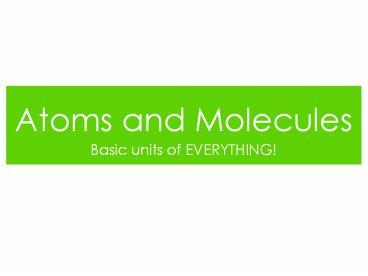Atoms and Molecules PowerPoint PPT Presentation
Title: Atoms and Molecules
1
Atoms and Molecules
- Basic units of EVERYTHING!
2
Atoms
3
In our model of scale, remember that the BB
represented an atom.
4
Hydrogen
Helium
As a class, identify the atoms represented here
and label the sub-atomic particles.
5
What elements are represented here? Use the
Periodic Table on the wall to identify these
atoms. What does the term valence shell mean?
Label the valence shell on each of these.
6
Ions
Loss or gain of an electron makes an atom into an
ion.
Losing an electron makes a positive or negative
ion?
-
Gaining an electron makes a positive or negative
ion?
-
7
Isotopes
Atoms that gain or lose a neutron become
isotopes. Radioactive isotopes are used in
medicine for imaging (such as PET scanners).
8
Why is this important?
- Each element has distinct properties color,
melting point, reactivity, etc. - The basic atomic structure of each element
determines that elements properties. Change the
structure, and you have an entirely different
element.
9
Atoms bond together
- Molecules are made up of atoms bonded together.
- The structure of an individual atom determines
- Whether the atom can form bonds.
- How many other atoms it can bond to.
10
In our model of scale, remember that the marble
represented a small molecule, such as glucose.
11
How many atoms can each of these atoms bond
with? How do we know?
12
Fill in the blank column with number of covalent
bonds formed by each atom.
13
Ionic Bonding
14
Ionic substances tend to form crystaline lattices
rather than distinct molecules.
15
Covalent Bonding
Co together valent valence shells
The hydrogen atom. How many bonds can it form?
16
Covalent bonding
A hydrogen molecule. How many hydrogen atoms are
involved? Can there be more? Why or why not?
17
Covalent Bonding
18
Polar bonding between atoms produces a polar
molecule, which has areas with slightly positive
or slightly negative charges.
19
Why is polarity so important?
Salt dissolves in water.
Oil does not.
Why?
What will oil dissolve in? Why?
20
Molecules bond together
Weak attractive forces between molecules are
called hydrogen bonds.
21
Here, sugar (a polar substance) is in solution
with water (also polar). Mark where the hydrogen
bonds will form.
22
Properties of Water
- Water is
- Cohesive
- Adhesive
- A universal solvent
- Water also has
- A high specific heat
- A high heat of vaporization
23
pH is a ratio between H and OH- ions in solution.
24
Recap
- What is the difference between atoms and
molecules? - What is the difference between ionic bonding and
polar covalent bonding? - How is polarity related to pH?

